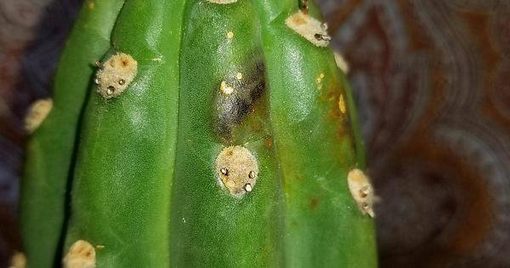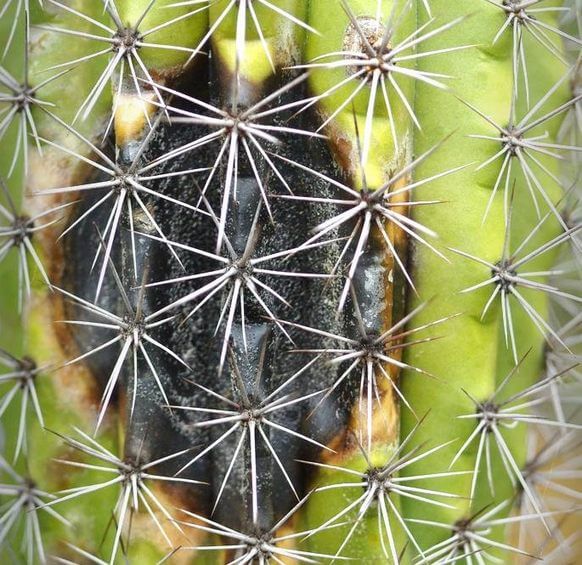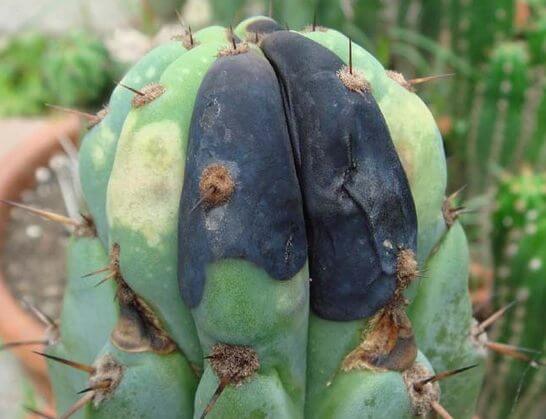Have you ever seen a Black Spots on Cactus? Although black spots on cacti may be disconcerting, identifying the cause enables you to prevent or reverse the harm. Common causes include fungal diseases, bacterial necrosis, root rot, or mechanical damage. This article covers ways to avoid such blemishes and maintain healthy cacti.
What Causes Black Spots on Cactus?
I remember the first time I spotted a cactus with black spots. I was horrified, as I had no idea what could be causing such an eyesore on my beloved plants.
After researching, I discovered that several factors caused these spots, including fungal diseases, bacterial necrosis, root rot, and mechanical damage. Overwatering or poor air circulation can cause fungal infections by allowing spores to grow on the whole plant. Giving too much direct sunlight or too much fertilizer can cause bacterial necrosis.
If cacti are planted in too damp soil, they can get root rot. Accidentally bumping your cactus when handling or watering it can cause mechanical damage.
Preventing Black Spots From Appearing
To prevent these black spots from appearing on your cacti, water them sparingly and avoid over-fertilizing them. Additionally, ensure that there is adequate air circulation around the plants and try to avoid any direct contact with them during maintenance.
If you have already noticed black spots starting to form on your plants, you can use a fungicide spray or dip to help get rid of the fungus and then repot them in fresh soil for better drainage. These easy steps will help keep your cacti healthy and free from unsightly dark spots!

Brown spots
Brown spots can also signify dryness and decay, particularly if they have a papery texture. If you have noticed these spots on your cacti, acting quickly before the problem spreads is crucial. You can address this problem by carefully removing any spotted areas with a clean knife and avoiding over-watering or over-fertilizing.
In some cases, applying fungicide spray may also help clear away brown spots, but it is best to visit a professional for more extensive advice.
With the proper care and maintenance, you can ensure that your cacti species stay healthy and free from dark spots. And if you’re looking for more succulent inspiration, stay tuned for our next article on some of the most common types of cacti plants!
Common Types of Cacti Species
I’m always amazed by the variety of cacti out there! From the tall and spiky to the small and round, a vast range of shapes and sizes can cater to any gardener’s needs.
Whether you’re looking for something low-maintenance or an exotic showstopper, here are some of the most common types of cacti to choose from:
Barrel Cactus
The barrel cactus is one of the most recognized varieties out there. It has a distinct shape with its round body and curved ribs and can reach up to two feet in height. The saguaro is another popular type that has long arms that appear as if it’s waving hello! These majestic plants can grow up to 40 feet tall in their native environment.
The prickly pear is made up of flat pads covered in fierce-looking spikes, but don’t be intimidated because they’re surprisingly soft.
Lastly, we have the hedgehog cactus, which looks like a fuzzy sphere of dozens of tiny spines.
Prickly Pear Cactus
The prickly pear cactus is an edible cacti species and can be found in different regions throughout the world. On some varieties of Prickly Pear Cactus, dark spots may form on the flat pads. These spots are caused by a fungus-like pathogen and can affect the result of photosynthesis in the cactus.
It’s crucial to identify Prickly Pear Cactus with signs of black spots as soon as possible to prevent the spread of infection or further damage to the plant.
Saguaro Cactus
Another common cacti species is the Saguaro Cactus, found in the deserts of North America. It has a tall, tree-shaped structure, and its flatly-jointed arms can branch out in many directions. Unlike Prickly Pear Cacti, black spots are generally not caused by a fungal infection on a Saguaro Cactus. However, other elements, such as sunlight exposure, unhealthy soils, or incorrect watering, may cause brown patches on the ridged ribs of the cactus.
Remember to take proper care of your cacti, no matter what type you go for, so they don’t get any black spots! Follow our tips on watering and fertilizing, ensure adequate air circulation around them, and avoid direct contact when handling them. With these simple steps, your cacti will stay healthy and thriving for years!

Causes of Black Spots on Cactus
I’m a big fan of cacti — I’ve been growing them for years, and I love their unique shapes, colors, and textures. Recently, though, I’ve noticed black spots appearing on some of the plants in my collection. After researching, I discovered that several factors could cause these spots.
The most common cause is too much water or not enough air circulation around the plant. Cacti can develop root rot and black spots on their stems or leaves when overwatered. If your cactus doesn’t have enough air circulation, this can also lead to black spots forming due to fungal growth.
Another potential cause is direct contact with the spines or leaves of the cactus when handling it. This friction can cause small abrasions, which then become infected with bacteria and fungi, leading to black spots appearing on the surface of the plant tissue.
To prevent black spots from appearing on your cacti, you should provide them with proper care, including adequate watering and fertilizing, good air circulation around them, and be careful when handling them so that you don’t accidentally damage any parts of the plant!
Cacti are a beautiful addition to any home or garden, and with proper care, you can keep them looking their best. Don’t forget that prevention is vital for black spots – regular maintenance and careful handling of your cactus will go a long way in keeping them healthy! But what if the black spots are due to something else? Stay tuned for our next section to learn about common fungal diseases found on cacti.
Fungal Diseases
Recently, I noticed some black spots on the leaves of my cactus, and after doing some research, I discovered that fungal diseases could cause these spots. Fungal diseases are common in plants and can cause discoloration, rotting, and wilting of the plant’s tissues. In cacti, these diseases are typically caused by over-watering, too much humidity, or contact with infected soil.
Signs of a Fungal Infection
If you see your cactus is sick, it may have a fungal infection. To prevent it from spreading, you need to take immediate action. Start by removing any parts of the plant that are affected. Then, disinfect your tools with rubbing alcohol or bleach solution.
Let the soil dry out completely before watering the cactus again. This is important because it will stop the fungus from growing. You can also increase air circulation around the cactus. This will make it less humid and decrease the chances of further infection.
Fungal diseases have reproductive structures that allow them to spread quickly, even between cacti kept in different places. This means it’s essential to identify and eliminate them early to thwart any further infection. Be sure to look for signs of the reproductive structure, such as small black spots or fluffy white patches, as these indicate that your cactus has a fungal disease and needs attention immediately.
Fungal spores are easy to spread, so it’s important to stay vigilant regarding containing and stopping the infection. Sterilize anything that has come into contact with a cactus affected by fungal diseases, and ensure you’re wearing gloves and other protective wear when tending to infected plants. Additionally, keep un-affected plants away from those who are, as this can help reduce the risk of contamination or spreading the infection.
Finally, suppose your cactus is exhibiting signs of a fungal disease despite your best efforts at prevention and care. In that case, you may need to consult a professional for treatment options and advice on how to avoid this in the future. Your cacti can remain healthy and free from disease with proper care and attention!

Bacterial Necrosis
I saw black spots on my cactus‘s leaves. I found out it could be a germ called Bacterial Necrosis. It can turn cactus leaves brown and makes them rot. This germ likes too much water or soil that already has germs in it.
If your cactus has Bacterial Necrosis, act fast to stop it from spreading. Remove any affected parts of the plant and clean any tools used. Wait until the soil is dry before watering, and increase airflow to reduce humidity.
Finally, suppose your cactus is exhibiting signs of this bacterial infection despite your best efforts at prevention and care. In that case, you may need to consult a professional for treatment options and advice on how to avoid this in the future. Your cacti can remain healthy and free from disease with proper care and attention!
Root Rot
Recently, while inspecting my cactus, I noticed some black spots on the leaves. After researching, I discovered this could be caused by a bacterial infection known as Root Rot. This type of infection occurs when there is too much moisture or contact with infected soil.
If your cactus shows signs of Root Rot, it’s essential to take immediate action. This includes removing any affected parts of the plant and disinfecting any tools used with rubbing alcohol or bleach solution before using them again. Additionally, it would help if you allowed the soil to dry out entirely before re-watering and increased air circulation around the area to reduce humidity levels.
In addition to Root Rot, another type of fungal infection that can affect cacti is called Crown Rot. Symptoms include black or brown spots all over the plant and a softening and collapse at the soil’s surface. Fortunately, you can use various treatments to combat this disease, including adjusting water and light levels and removing any affected portions of the cactus.
If all else fails, it’s time to seek professional help for treatment options and advice on how to avoid this. Your cacti can remain healthy and free from disease with proper care and attention!
Excess Water
While inspecting my cactus, I discovered black spots on the leaves that looked like a bacterial infections. After researching, I found out this could be caused by excess water or contact with infected soil. It’s essential to take immediate action if your cactus shows signs of Root Rot.
When taking care of your cactus, you need to be careful. If you see any parts of the plant that are affected, you need to remove them. It would help if you also disinfected any tools you use before using them again, and you can do this with rubbing alcohol or bleach solution. Before re-watering your cactus, make sure the soil is dried. Also, increase air circulation around the area to reduce humidity levels.
Too much water can cause root rot, which can be very harmful and even kill your cactus. Taking proper care and paying attention to water levels are essential for keeping your cactus healthy and happy!
Pruning Shears or Other Mechanical Damage
Recently, while tending to my cactus, I noticed some black spots on the leaves. After some research, I discovered these dark spots could be caused by mechanical damage such as pruning shears. It’s important to inspect your tools regularly and ensure they are free of dirt and debris before using them on your indoor plants.
Additionally, make sure you’re cutting in a safe spot that won’t damage any other parts of the plant. If you do notice signs of mechanical damage, take immediate action by pruning off any affected areas and disinfecting your tools with rubbing alcohol or bleach solution before using them again. Taking proper care and paying attention to details are essential for keeping your cacti healthy and happy!

Direct Sunlight/Bright Light/Warm Temperatures
Recently, I noticed some black spots on the leaves of my cactus. After a bit of research, I discovered these dark spots could be caused by too much direct sunlight or bright light. Cacti need plenty of sunshine to thrive, but they also require periods of shade or indirect light throughout the day.
Additionally, warm temperatures can cause damage and stress to your plant, which can result in the appearance of black or dark spots. If you live in a warm climate, make sure to protect your cactus from strong direct sunlight and provide some shade during the hottest part of the day. Taking proper care and paying attention to details are essential for keeping your cacti healthy and happy!
Prevention Strategies for Black Spots on Cactus Plants
If you have a cactus plant, you may have noticed some black spots on its leaves. Sometimes cacti can get a problem called sunburn. This happens if they get too much direct sunlight or are too warm. To stop this, give them the right amount of sunlight and shade. If you live in a hot place, give them shade when it’s the hottest part of the day.
Another great way to protect your cactus from getting black spots is by using a special potting mix designed specifically for them. This will ensure proper drainage and aeration while providing essential nutrients. Additionally, make sure not to overwater your cactus and avoid exposing it to too much wind or cold temperatures, which can also cause damage and stress that result in black spots.
Taking good care of your cactus is essential for keeping it healthy and happy! With the right amount of sun exposure and protection from extreme temperatures, you should be able to keep those pesky black spots away!
To keep your cactus healthy, do a few things. Please don’t give them too much or too little sunlight and shade. Use special soil and only water them a little. There’s more you can do, too – we’ll talk about it next!
Use Indirect Lighting and Cooler Temperatures in the Room.
Cactus lovers should use indirect light and cooler temperatures to stop black spots from appearing. It is also important to give them the right amount of direct sunlight and shade during the day. Keeping cacti in an area with indirect light can help them stay healthy and stress-free.
To keep your cactus healthy, lower the temperature in the room. Too much heat or cold can give them black spots. Make sure to give them enough indirect light too. If you do this, your cactus should be able to grow well and be healthy!
If you want to keep your cacti healthy, try these simple things. They can stop black spots and other damage. Keep your plants from getting too much direct sunlight or too hot or cold. Try these tips, and your plants will be happy and healthy!
Avoid Overwatering.
As someone who has been growing cacti for years, I can attest to the importance of avoiding overwatering. It is easy to think that a little extra water won’t hurt your cactus, but too much water can cause the soil to become waterlogged and lead to rot. This can damage not only the plant itself but also cause black spots or other discoloration on its surface.
It is always best to err on the side of caution when it comes to watering your cactus plants. Make sure you know exactly how much water they need and stick with that amount – no more, no less! Additionally, be sure to allow the soil to dry out completely between waterings so that your cactus isn’t sitting in dampness for extended periods of time.
Finally, consider investing in a moisture meter or hygrometer for extra assurance. You can use some tools to check if the soil is too wet or too dry for your cactus. These tools will help you make sure that the soil is just right for your plant and will keep it healthy and free from black spots.
Inspect Your Plant Regularly for Insects and Diseases.
As a cactus enthusiast, I emphasize the significance of frequent plant inspection to detect pests and diseases. Insects such as aphids, mealybugs, and scales can cause black spots. Hence swift action is necessary. Also, monitor for fungal and bacterial illnesses resulting from overwatering or environmental factors.
If you spot any of these issues on your cacti, don’t hesitate to take action!
For pest control without harming the plant, apply insecticidal soap or neem oil directly to the affected parts. For black spots caused by disease, adjust cultural practices, and remove infected areas promptly.
If a cactus has been infected with bacteria or fungus, it might take some time for all of the discolorations to disappear. But with proper care and attention, you can keep your cacti looking their best!
Sanitize.
Sanitizing your cacti is an essential part of keeping them healthy and vibrant. I love cacti, and I want to make sure they stay healthy. To do that, I clean them often using a mild soap solution or rubbing alcohol. This will remove any bacteria or fungus that can cause black spots on the cacti.
This simple step can go a long way in preventing issues from occurring in the first place!
Additionally, it’s important to regularly inspect your cacti for any signs of insects or disease. Catching these issues early on can help you take the necessary steps to prevent further damage.
It’s important to sanitize and inspect your cacti regularly to keep them looking their best and staying healthy. Doing this will help your cacti to stay happy for many years.